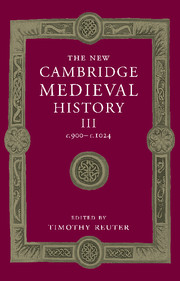Book contents
- Frontmatter
- 1 Introduction: reading the tenth century
- PART I GENERAL THEMES
- PART II POST-CAROLINGIAN EUROPE
- PART III NON-CAROLINGIAN EUROPE
- 19 European Russia, c. 500–c. 1050
- 20 Bohemia and Poland: two examples of successful western Slavonic state-formation
- 21 Hungary
- 22 Byzantium in equilibrium, 886–944
- 23 Bulgaria: the other Balkan ‘empire’
- 24 Byzantium expanding, 944–1025
- 25 Byzantium and the West
- 26 Southern Italy in the tenth century
- 27 Sicily and al-Andalus under Muslim rule
- 28 The Spanish kingdoms
- Appendix genealogical tables
- List of primary sources
- Bibliography of secondary works arranged by chapter
- Index
- Frontispiece
- Plate section
- Map 2: Archbishoprics and bishoprics in the early eleventh century
- Map 4: Germany
- Map 13: Byzantium in 1025
- References
26 - Southern Italy in the tenth century
from PART III - NON-CAROLINGIAN EUROPE
Published online by Cambridge University Press: 28 March 2008
- Frontmatter
- 1 Introduction: reading the tenth century
- PART I GENERAL THEMES
- PART II POST-CAROLINGIAN EUROPE
- PART III NON-CAROLINGIAN EUROPE
- 19 European Russia, c. 500–c. 1050
- 20 Bohemia and Poland: two examples of successful western Slavonic state-formation
- 21 Hungary
- 22 Byzantium in equilibrium, 886–944
- 23 Bulgaria: the other Balkan ‘empire’
- 24 Byzantium expanding, 944–1025
- 25 Byzantium and the West
- 26 Southern Italy in the tenth century
- 27 Sicily and al-Andalus under Muslim rule
- 28 The Spanish kingdoms
- Appendix genealogical tables
- List of primary sources
- Bibliography of secondary works arranged by chapter
- Index
- Frontispiece
- Plate section
- Map 2: Archbishoprics and bishoprics in the early eleventh century
- Map 4: Germany
- Map 13: Byzantium in 1025
- References
Summary
the seventy years before 900 were an era of disorder and continued crisis in southern Italy. The government of the principality of Benevento, which ruled over most of the south of the peninsula, was riven by succession disputes which led to the formal partition of the principality in 849. But, far from ending the contention, this division gave only a brief pause in the internecine strife. Muslim attacks from Sicily and North Africa threatened to swamp a feeble and divided Christian defence, and the local rulers were far more intent on their internal power struggles than on making any coherent and effective stand against the invader. However, the years round about 900 marked a very significant change, with regard both to the internal stability of southern Italy and also to its relative freedom from external threat (or at least from the threat of conquest rather than sporadic raiding). For much of the tenth century the land was to be, if not exactly peaceful, at least freed from the dreary litany of civil war and the establishment of territorial footholds for further Muslim advance that had made the previous period a time of trouble and strife, the impact of which was reflected in the prevailing pessimism of contemporary chroniclers such as Erchempert, and in the number of contemporary charters mentioning relatives captured by the Saracens.
This change was marked by three factors. First, there was the revival of Byzantine power in the late ninth century. Under the governorship of Nikephoros Phokas in the 880s the Byzantines had recovered much of northern Calabria and consolidated their hold in southern Apulia. The creation of the new thema (province) of Langobardia at this period was part of the process of consolidation, as was the creation of new dioceses in Calabria after 886. Visits by local rulers to Constantinople (those of Guaimar I of Salerno in 887 and Landulf I of Benevento in 910), as well as the use once again of the regnal years of the Byzantine emperor in the dating clauses of documents from both the cities of the west coast and the Lombard principalities, demonstrate the restored prestige of the empire.
Keywords
- Type
- Chapter
- Information
- The New Cambridge Medieval History , pp. 624 - 645Publisher: Cambridge University PressPrint publication year: 2000
References
- 1
- Cited by

